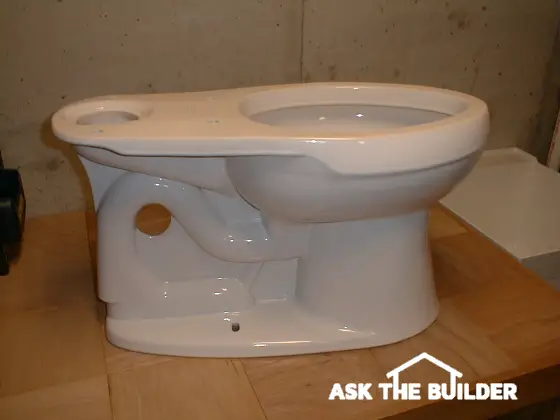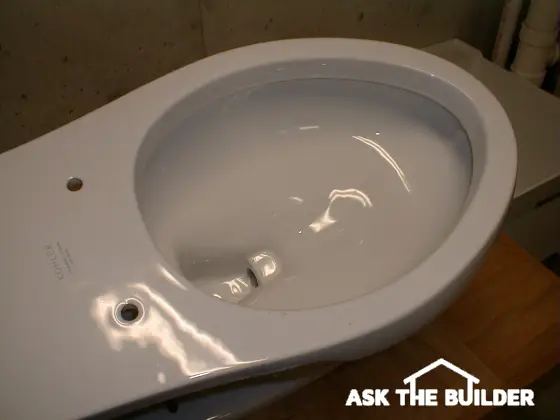Toilet Size Specs – 10 12 & 14

Toilet Size Specs | It's a standard 12-inch rough-in. This is a fairly standard toilet bowl. Note the exposed colon of the toilet. It is the snake-like bulge that leaves from the left-bottom of the bowl and travels up and over the hole. The end of the colon is right at the base of the toilet foot where you see the small hole for the toilet bolt.
"The most common dimension is 12 inches from the finished wall surface."
Toilet Size Specs - 12 Inches is the Magic Number
DEAR TIM: I am looking at toilets for my new bathroom. Our current toilet measures 23 inches from the back wall to the front edge of where the toilet touches the floor. Many of the measurements in brochures seem to start at nearly 27 inches. Space is valuable in this small room. We also have a flushing problem with our current toilet. It seems to always require two or three flushes to rid the bowl of waste. Karen N., Williamstown, NJ
DEAR KAREN: I don't think you are comparing apples to apples. You measured the foot extension of the toilet. The foot is the actual surface dimension and shape of where the toilet bowl base contacts the floor. Bathroom planners and plumbers are rarely interested in that dimension. The most critical dimension is the distance from the front of the bowl where the toilet seat contacts the china bowl to the back of the toilet. My guess is that if you measure your existing toilet, you will quickly discover it extends 27 or even 28 inches from the back wall.
What is the rough-in dimension of a toilet bowl?
An often overlooked measurement is the rough-in dimension of the toilet bowl. This measurement is the distance from the back of the toilet to the center of the waste outlet hole on the underside of the toilet bowl.
It's important to realize this dimension is measured from the finished wall surface.
The most common dimension is 12 inches from the finished wall surface. But many toilet manufacturers also offer two other sizes in case mistakes are made during construction or a pesky floor joist gets in the way. It is not unusual to find toilets with a 10 or 14 inch rough-in dimension. Be sure you purchase a toilet bowl that has the correct rough-in dimension to match your current drainage pipe location.
Be aware you can also use an offset flange to get past a pesky floor joist. CLICK or TAP HERE to get an offset flange.
Do low flush toilets actually save water?
Toilet technology has made significant advancements in the past seven to ten years. In fact, certain manufacturers continue to devote significant research and development resources to toilet design and functionality. There are millions of consumers who are disappointed with the performance of toilets since the low flush water savings law was enacted in January of 1994. You are a perfect example of how that law has backfired. The intent was for toilets to save water by using less water per flush. But if you flush twice or even three times, you may end up using even more water than with an older 3.5 or 5 gallon per flush model.
CLICK or TAP HERE to get FREE quotes from local plumbing companies to install your new toilet.
How Do Toilets Flush?
Flushing toilets is all about physics and stored potential energy. The water that is at rest in the tank just before the flush has the ability to do work because of its weight and the pull of gravity once the flush handle is activated.
For the flush to be complete, this water needs to enter the bowl as rapidly as possible and encounter as little friction as possible as it leaves the bowl on its way to the drain.
You can buy toilets that have enormous three and one-quarter inch flush valve openings at the bottom of the tank. These same toilets have fully-glazed trap-ways so the water and waste slips through the toilet with minimal friction.

Look at the bottom of the empty bowl. You can see the siphon-jet hole where the water from the tank starts to force water and waste into the colon.
Certain toilets are so well-engineered they can flush solid waste with just 1.4 gallons of water per flush instead of the industry standard of 1.6 gallons of water. This small savings per flush can add up to big savings over time. A family of four using one of these toilets can save nearly 2,000 gallons of water per year. Imagine how much water could be saved if an entire subdivision or city used these toilets.
What other advancements have been made in toilet design?
The advancements in toilet design do not stop at the toilet bowl. You or your plumber can now buy new toilets that take the hassle out of connecting the tank to the toilet bowl. In years past, I and many others struggled with bolts and washers that passed through holes in the bottom of the tank. Tighten the bolts too much and you risk cracking the china. If the bolts were not tightened enough water would leak through the bottom of the bowl.
A new tank design eliminates these holes by using a hidden steel plate on the underside of the tank. The bolts lock into the steel plate and then pass through the holes in the back of the toilet bowl. It is an ingenious concept that will save both time in installation and service calls created by leaks.
Received April 12, 2004:
"This is the first column I have read by anyone that so correctly details how the 1.6 gallon toilets work. My company has installed over 60,000 low flow 1.6 GPF toilets in the Tampa Bay area with virtually no trouble. In fact, the only problem we have is with competing plumbers who say ' ...those new toilets don't work!' Thanks for setting the record straight." Lou Bernucca
Author's Note: Thanks Lou! I am humbled to get praise from a fellow licensed plumber. TC
Low-quality toilets can have a hidden defect that is often very hard to see. Toilets have a colon inside of them that is simply the path of the trapway. The trapway is the internal sealed tube that connects the bowl with the drain exit hole at the base of the toilet. It serves the same purpose as the trap drains one sees under a standard kitchen or bathroom sink. This colon used to be hidden on many older toilets but it is now common to actually see the convoluted pathway the water and waste takes as it travels from the bowl to the drain hole in the floor.
Why do some toilets clog or are hard to flush?
Toilets that are hard to flush or that clog on a frequent basis may be the victims of poor colon design. You can clearly see the colon of a toilet in the top photograph. The bends within the colon may be too tight. The actual interior size of the colon may be small. Try to buy toilets that have a two inch minimum trapway/colon or those that have even large diameter colons. Ask the plumbing supply sales person to show you different toilets with exposed colons so you can see how some have better streamlining than others.
6 Responses to Toilet Size Specs – 10 12 & 14